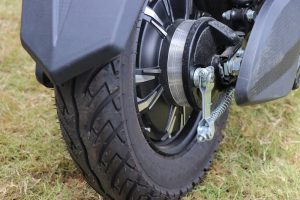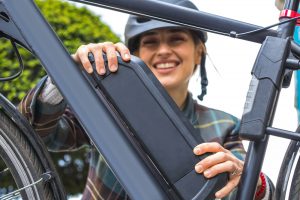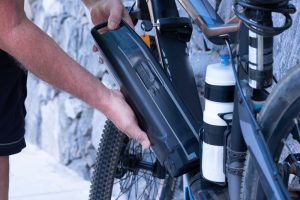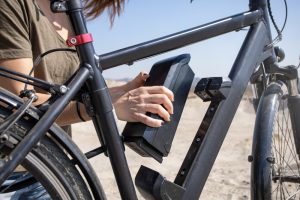What is an e-bike?

As soon as you hear the word ‘electric bicycle’, you might imagine it to be something similar to a scooter or a motorbike. But, it’s simply an ordinary bicycle connected with several electrical components, which makes it an e-bike. These components give a slight push to the bike, enabling you to ride it smoothly. Nothing could even come close to that thrilling feeling of riding an e-bike! I’m pretty sure you would feel like superman flying over the clouds! Who wouldn’t like to feel this way?
What’s the demand for e-bikes?

The demand for e-bikes has grown, with the global electric bike market valued at USD 49.7 billion in 2022 and expected to reach USD 80.6 billion in 2027. The reasoning behind this increasing demand would undoubtedly be the rocketing fuel prices, environmental damage such as global warming caused by the emission of greenhouse gases via vehicles, and the health issues many people currently face. With the use of e-bikes, you would surely be able to keep yourself fit and healthy, plus contribute to saving this world by pedaling.
So how do e-bikes work?

As said before, an e-bike is a bicycle that has several electrical components. They work together to allow the bike to operate. The main features are an electric motor, the battery, the sensor, and the electric display. Further, all electric bikes have a pedal assist. Here, the engine will only activate if the pedals are in motion. With this, the rider could ride the bike easily with the extra boost given by the motor. Plus, they could still get a workout by pedaling.
Deep down to the three major components

A quick reminder; the three major components needed are the electric motor, the battery, and the sensor.
Motor – The Booster

The primary role of the motor is to give torque when the rider pedals. Here’s how it works. If you’ve got an advanced engine, which means that it has more power, the more torque, it will be able to provide you with. And consequently, when you have more torque, you can get more ability out of the bike. The motor will also be automatically switched on when you pedal.
Mainly, there are two different types of motors; motors in the crank and engines in the rear hub. Regardless of their differences, they both have their positives and negatives.
Sensor – The most important

This is a tremendously important component of an electric bike. The reasoning is that many e-bikes rely on their sensors to determine when their motor power is necessary to assist in cycling and boost the pedaling force.
The two significant types of e-bike sensors are cadence sensors which measure the pedaling rate, and torque sensor, which measures how hard the rider is pedaling.
Battery – The charging component

The battery in an electric bike is the component that gives it the name electric. And this concept of an e-bike revolves around a storm. This is another one of the most critical components of an electric bike, plus the most expensive! The battery of an electric bike could be located anywhere in the cycle, depending on its frame type and size. Different batteries of different batteries make, styles, and models mean that they need to be charged for a different number of hours. It is dependent. On average, the charging time of an e-bike battery could be around 5 to 6 hours.
More about the Battery

As the battery of an electric bike is one of its most essential components, you should be concerned when choosing the correct battery. Let’s get deeper down into this topic.
So how do you choose the correct battery?

As said, the concept of these e-bikes depends on the battery that they are using. So, it is indeed really significant to choose the correct battery. But unfortunately, this has become so challenging with the rapidly evolving technologies. There are some major essential factors to be considered when it comes to choosing the correct battery. In this case, you should consider the range and speed required for your e-bike. Here are the most critical factors to be considered.
The first factor to consider when choosing the correct battery, of course, would be its cost. Because no matter how good it is, if you can’t buy it, right? But, remember, the charge of the battery could also define its quality. Next is its specific energy density, which tells the amount of energy per kg unit of the storm. For example, if your bike is lightweight, you should look for a battery with a high specific energy density. Volume energy density should also be taken into consideration.
The life cycle of the battery, when it will discharge from 100% to 0%, should be checked too. Usually, Lithium-ion batteries have around 2000 life cycles. The battery’s capacity, which shows the storm’s energy rating, is also essential. Higher the degree, the higher the distance that can be traveled in one charge. The charging rate is the current amount needed to charge the battery for an hour. When the amount of current is increased, it means fast charging but can reduce the battery’s life. Finally, the battery management system, the lab certification, casing, and other standards need to be checked to ensure the battery’s safety and disposability. So, these factors would reflect the difficulty of choosing the correct battery.
The types of batteries that could be used in e-bikes

So, a vast kind of battery could be used in e-bikes. Below are some of them.
Lithium-ion
Nickel-cadmium
Lithium cobalt
Lead-acid
Nickel-Metal-Hydride
Lithium manganese
Lithium-ion polymer
Of these batteries, many agree that Lithium-ion batteries would be a great option for electric bikes. And also, although lead acid batteries are cheaper, they are about three times heavy as lithium-ion batteries.
How is the battery size related to its function?

Generally, the bigger the battery, the more capacity it has. This means that the bigger the storm, the more power it has. But still, larger batteries won’t suit many e-bikes as they do not have ample space.
So, what’s the best at the end?

This is undoubtedly a complicated question to answer. When choosing the correct battery, there are hundreds of factors to consider. And, sometimes, even if a particular battery is good enough for me, it might not be good enough for you. And even if you consider all those factors and choose the best, it still needs good care to function properly.
Battery packs are made of individual battery cells. And these cells could be cylindrical cells or prismatic cells. Plus, these batteries are manufactured in various form factors (the size). Commonly, the form factor used in the storms of electric bikes is 18650.
